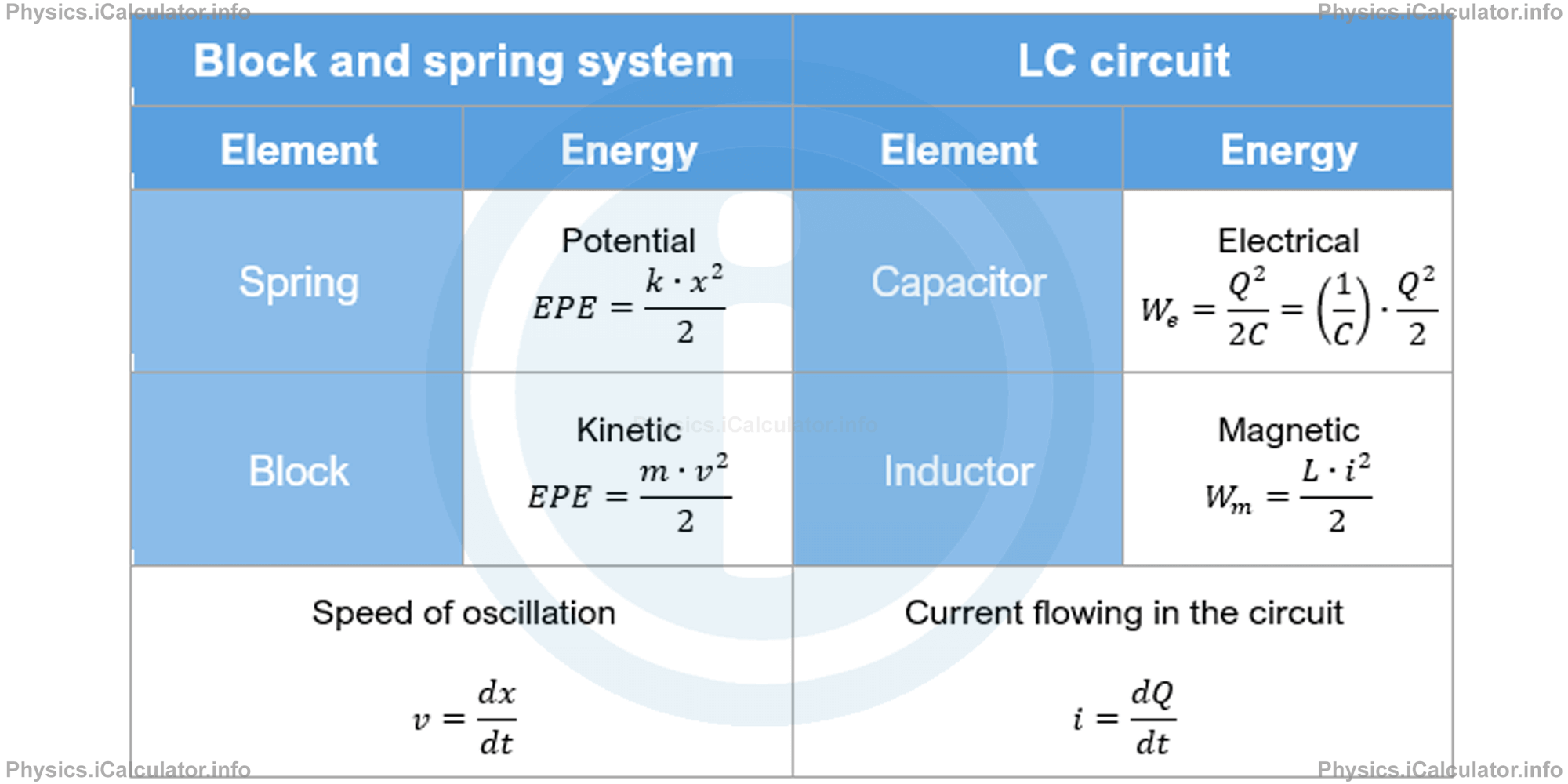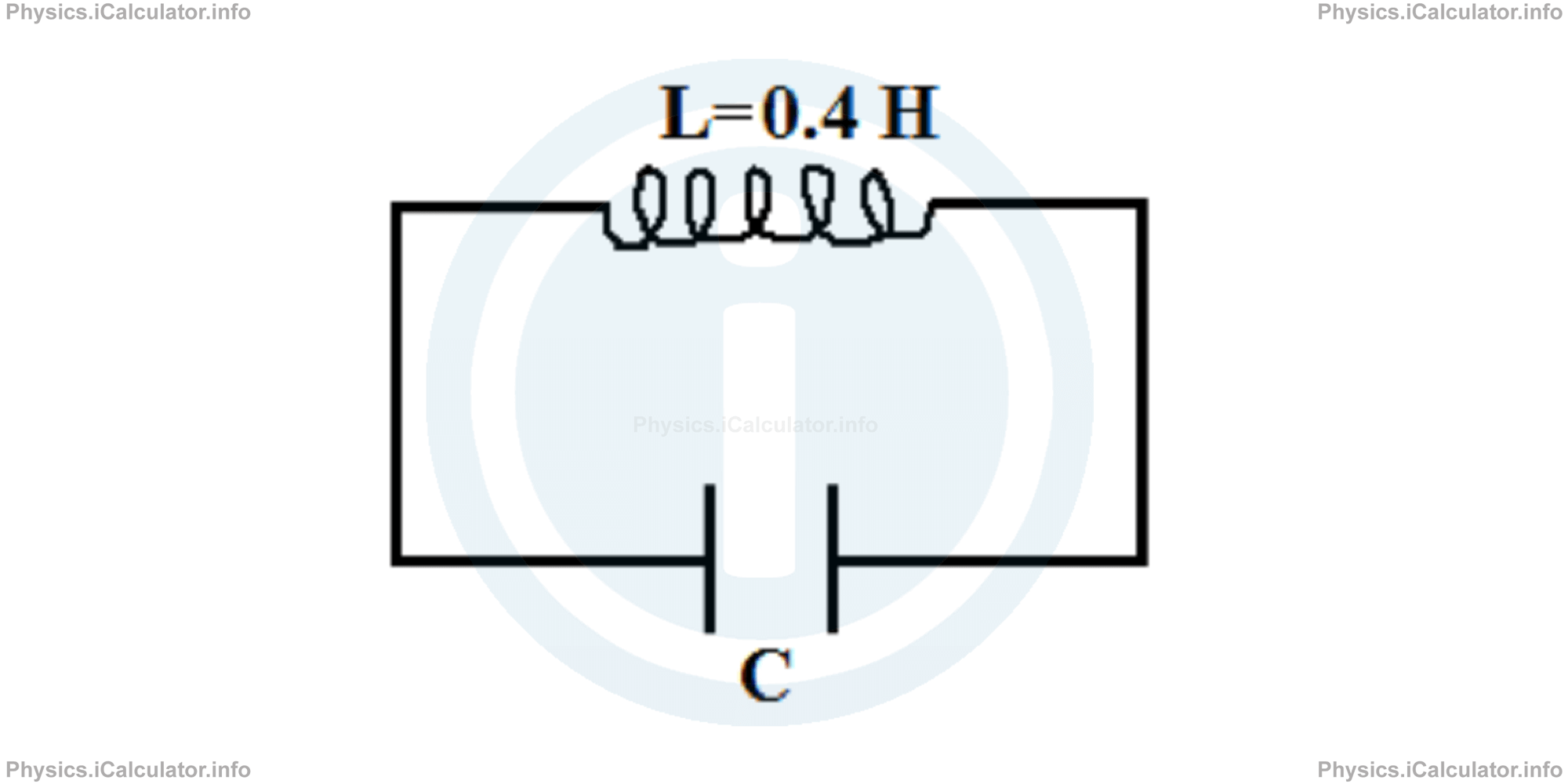Menu
Physics Lesson 16.14.2 - Electrical to Mechanical Analogy between Two Oscillating Systems
Please provide a rating, it takes seconds and helps us to keep this resource free for all to use
Welcome to our Physics lesson on Electrical to Mechanical Analogy between Two Oscillating Systems, this is the second lesson of our suite of physics lessons covering the topic of Alternating Current. LC Circuits, you can find links to the other lessons within this tutorial and access additional physics learning resources below this lesson.
Electrical to Mechanical Analogy between Two Oscillating Systems
As stated earlier, an oscillating block and spring system represents a good analogy when trying to understand the behavior of quantities involved in a LC circuit, as both systems oscillate in a sinusoidal fashion. Thus, there are two types of energy involved in the block and spring system: one is kinetic (due to the block movement) and the other is (elastic) potential (stored in the spring). Neglecting the friction in the block and spring system and resistance in the LC circuit, we have
for the block and spring system and
for the LC circuit. The following table makes this point clearer.

From the above table, it is easy to deduce the following correspondences:
k ⇢ 1/C
v ⇢ i
m ⇢ L
In Section 11 (more precisely in tutorial 11.2 "Energy in Simple Harmonic Motion"), we have seen that the general equation for the angular frequency ω of a SHM is
where T is the period of oscillation (i.e. the time needed to complete one oscillation). When applied for the mass and spring system, the equation of angular frequency becomes
where k is the spring constant and m is the mass of the attached object.
Substituting 1/C for k and L for m, we obtain for the angular frequency of a LC circuit:
= √1/L ∙ C
= 1/√L ∙ C
Giving that
where f is the frequency of oscillations in Hertz, we obtain for the frequency of oscillations in a RL circuit (electrical frequency):
or
The value of electrical frequency in US, Canada, Brazil, Colombia, some regions in Japan and some small countries in Central America is 60Hz, while in the rest of the world, this frequency is 50 Hz. This means the current makes 50 or 60 complete cycles in one second when flowing through an AC circuit.
Example 2
A LC circuit is operating somewhere in Europe. What is the capacitance of the capacitor if the inductance of the solenoid is 0.4 H?

Solution 2
Since the circuit is operating in Europe, the frequency of electricity must be 50 Hz. Therefore, giving that
we obtain for the capacitance C after raising both parts of the equation in power two to remove the root:
C = 1/4π2 ∙ f2 ∙ L
= 1/4 ∙ 3.14 ∙ (50 Hz)2 ∙ (0.4 H)
= 7.96 × 10-5 F
= 79.6 μF
You have reached the end of Physics lesson 16.14.2 Electrical to Mechanical Analogy between Two Oscillating Systems. There are 5 lessons in this physics tutorial covering Alternating Current. LC Circuits, you can access all the lessons from this tutorial below.
More Alternating Current. LC Circuits Lessons and Learning Resources
Whats next?
Enjoy the "Electrical to Mechanical Analogy between Two Oscillating Systems" physics lesson? People who liked the "Alternating Current. LC Circuits lesson found the following resources useful:
- Mechanical Feedback. Helps other - Leave a rating for this mechanical (see below)
- Magnetism Physics tutorial: Alternating Current. LC Circuits. Read the Alternating Current. LC Circuits physics tutorial and build your physics knowledge of Magnetism
- Magnetism Revision Notes: Alternating Current. LC Circuits. Print the notes so you can revise the key points covered in the physics tutorial for Alternating Current. LC Circuits
- Magnetism Practice Questions: Alternating Current. LC Circuits. Test and improve your knowledge of Alternating Current. LC Circuits with example questins and answers
- Check your calculations for Magnetism questions with our excellent Magnetism calculators which contain full equations and calculations clearly displayed line by line. See the Magnetism Calculators by iCalculator™ below.
- Continuing learning magnetism - read our next physics tutorial: Introduction to RLC Circuits
Help others Learning Physics just like you
Please provide a rating, it takes seconds and helps us to keep this resource free for all to use
We hope you found this Physics lesson "Alternating Current. LC Circuits" useful. If you did it would be great if you could spare the time to rate this physics lesson (simply click on the number of stars that match your assessment of this physics learning aide) and/or share on social media, this helps us identify popular tutorials and calculators and expand our free learning resources to support our users around the world have free access to expand their knowledge of physics and other disciplines.
Magnetism Calculators by iCalculator™
- Angular Frequency Of Oscillations In Rlc Circuit Calculator
- Calculating Magnetic Field Using The Amperes Law
- Capacitive Reactance Calculator
- Current In A Rl Circuit Calculator
- Displacement Current Calculator
- Electric Charge Stored In The Capacitor Of A Rlc Circuit In Damped Oscillations Calculator
- Electric Power In A Ac Circuit Calculator
- Energy Decay As A Function Of Time In Damped Oscillations Calculator
- Energy Density Of Magnetic Field Calculator
- Energy In A Lc Circuit Calculator
- Faradays Law Calculator
- Frequency Of Oscillations In A Lc Circuit Calculator
- Impedance Calculator
- Induced Emf As A Motional Emf Calculator
- Inductive Reactance Calculator
- Lorentz Force Calculator
- Magnetic Dipole Moment Calculator
- Magnetic Field At Centre Of A Current Carrying Loop Calculator
- Magnetic Field In Terms Of Electric Field Change Calculator
- Magnetic Field Inside A Long Stretched Current Carrying Wire Calculator
- Magnetic Field Inside A Solenoid Calculator
- Magnetic Field Inside A Toroid Calculator
- Magnetic Field Produced Around A Long Current Carrying Wire
- Magnetic Flux Calculator
- Magnetic Force Acting On A Moving Charge Inside A Uniform Magnetic Field Calculator
- Magnetic Force Between Two Parallel Current Carrying Wires Calculator
- Magnetic Potential Energy Stored In An Inductor Calculator
- Output Current In A Transformer Calculator
- Phase Constant In A Rlc Circuit Calculator
- Power Factor In A Rlc Circuit Calculator
- Power Induced On A Metal Bar Moving Inside A Magnetic Field Due To An Applied Force Calculator
- Radius Of Trajectory And Period Of A Charge Moving Inside A Uniform Magnetic Field Calculator
- Self Induced Emf Calculator
- Self Inductance Calculator
- Torque Produced By A Rectangular Coil Inside A Uniform Magnetic Field Calculator
- Work Done On A Magnetic Dipole Calculator